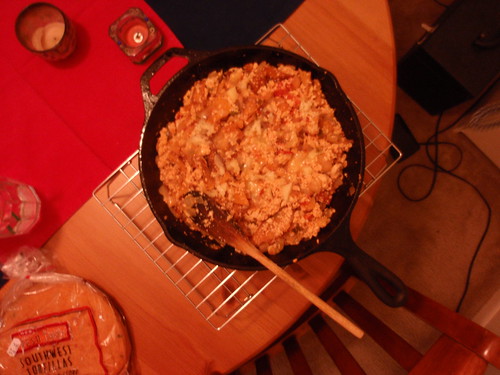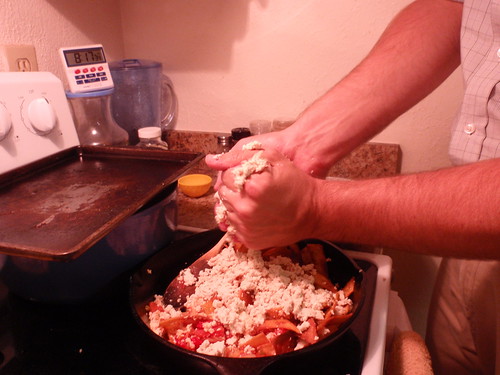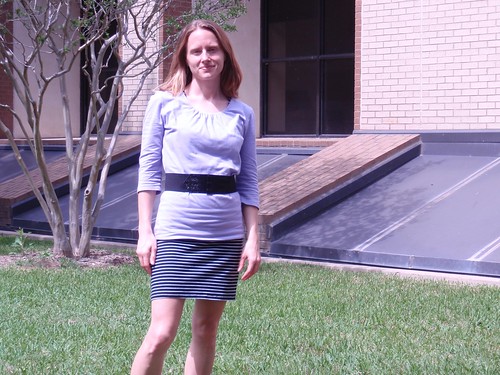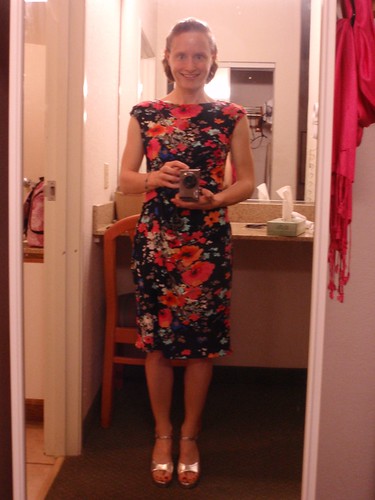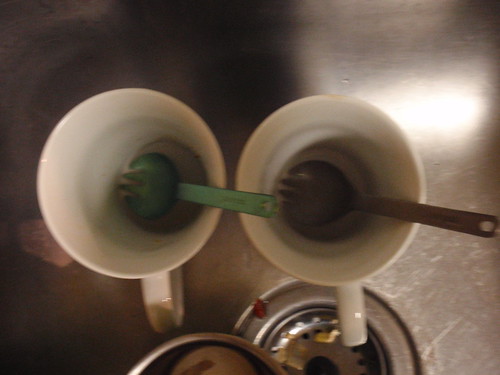It’s time for you to meet your new favorite recipe: Paul’s tofu migas.
This recipe has a fun story of origin, pulling inspiration from several friends. A few months ago, my friend Courtney came over and made delicious migas for us. Courtney tends to be a pretty traditional cook, so her migas were made with eggs, fresh onion and jalapeno, salsa, crispy home-fried tortilla strips, and fresh cilantro. After that mixture is cooked and combined, it gets wrapped in tortillas and topped with cheese for an outstanding dinner. Courtney made it for me once, and I was hooked. I made it for Paul, and he loved Courtney’s migas too.
Meanwhile, Paul and I have a friend, Jeremy, who taught Paul how to make a spicy tofu scramble with a texture that is very reminiscent of scrambled eggs. Paul and I are always planning delicious things we can make for Jeremy and his wife Amber, and Paul started to think about combining Courtney’s migas with Jeremy’s tofu technique. After a few trials, Paul’s famous tofu migas were born. One night, he let me follow him around the kitchen with my camera, documenting the protocol for all of you.
Paul starts by chopping an onion and cooking it down in some peanut oil. He chops a jalepeno pepper and adds it to the onion and that mess cooks down while he gets on with the tofu.
I think if you asked Paul, he’d say prepping the tofu right is the most critical step. The important thing is to squeeze out as much “tofu water” as possible. Paul does this by slicing a pound of tofu into six slabs and pressing it with a super-absorbent towel or cloth. You want the tofu to feel dry when you are done pressing it. (Meanwhile, chop two tomatoes and add them to the onion-pepper mixture. I like the sprinkle some salt in, too, while Paul isn’t looking. He underestimates the importance of salt.)
After the tofu is patted dry and the tomatoes have cooked down a bit, Paul crumbles the tofu straight into the pan. This step gives his tofu migas that scrambled egg texture. Here, Paul will demonstrate it for you:
Meanwhile, you need to fry some corn tortilla strips. It’s nice if there are two of you cooking because one of you can man the frying station while the other tends to the vegetables and tofu. If you’re a one-person migas operation, you can fry the tortillas while the vegetables cook down and the tofu is being pressed. I think that’s what Paul usually does if he’s cooking alone.
After the veggies have cooked down and the tofu has been added, it’s time to add the seasonings. Cholula is Paul’s favorite, and he adds it liberally to the migas. He also adds nutritional yeast for some savory oomph. Finally, the tortillas strips get folded into the tofu mix, we warm up some flour tortillas in a dry skillet, and, if we’re using it, we sprinkle some cheese over the migas.
Then it’s time to eat.
Everyone who has tried Paul’s migas loves them. A few months ago, Paul and I were visiting his parents, and he made migas for his mom, me, and himself. We had such a cozy breakfast together—it was really fun to share a favorite dish of ours with his mom. Since then, we’ve made migas for a big group of friends on the morning after Thanksgiving, for breakfast in the house where we stayed in New Orleans, and most of all, for ourselves. I think Paul makes migas every week at his house—his grocery list always includes migas ingredients.
And now, we pass the migas tradition along to you! Enjoy!
Paul’s Tofu Migas
Serves 2-3
This recipe is easily doubled, which is what we do when we’re cooking for four or more people. Also, the cheese is totally optional. We usually don’t add it, but if you do, vegan or dairy cheese is just fine. (Of course, when we make this dish for vegan friends, we use vegan cheese or skip the cheese altogether.)
A special note from Paul: “The difficult part of this recipe is getting the timings right. We want the onions to be getting kind of soft before we add jalapeños, and we want to get them pretty soft before we add the tomato. The tofu will take a while to dry out. Only add the tortilla strips just before serving, lest they get soggy.”
Peanut oil (enough for frying)
1 onion, diced
1 jalapeño, diced (optional: remove the seeds, too)
2 tomatoes, coarsely chopped
Salt to taste
1 16-oz. block tofu
5 corn tortillas
Cholula to taste
1-2 tbsp. nutritional yeast
Shredded cheese, vegan or dairy, your choice (optional)
4-5 flour tortillas
1) Over medium heat, heat a tablespoon of peanut oil in a large frying pan. Sauté chopped onion for a few minutes. Add the jalapeño and continue cooking. Let the veggies cook down, stirring them frequently, while you move on to the next step.
2) Drain and press the tofu. I do this by placing it between two plates and putting something heavy on top, like a big can of tomatoes. I pour off the liquid that comes out during pressing.
3) Meanwhile, in a smaller pan, heat a significant amount of peanut oil (about half an inch in depth). Chop the corn tortillas into thin strips and fry. Let them cool on paper towels.
4) Back to the veggies: add the chopped tomatoes to the onion mixture. Stir everything together and let it cook for a few minutes.
5) Blot the tofu with paper towels or a clean kitchen towel to draw out any remaining extra moisture. Crumble it into the pan by squeezing it in your fists, like the way a toddler squeezes Play-Do. The idea here is to give the tofu a texture like scrambled eggs. Stir the tofu into the veggies, then add the nutritional yeast, salt, and Cholula to taste.
6) Add the fried tortilla strips to the tofu mixture. Sprinkle with cheese if you’re using it.
7) Heat a dry skillet over medium heat. Gently warm the flour tortillas by placing them in the skillet briefly and flipping them over. Pile them on a plate.
8) Pile migas into the warmed tortillas, taco-style, and eat! Oh, so good…

